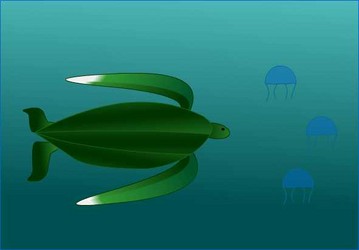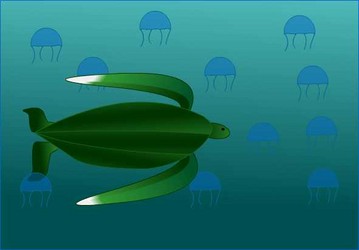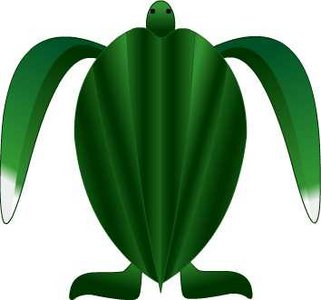Once upon a time, in the open sea in Atlantic Canada, a Dermochelys coriacea (Leatherback Sea Turtle), Suzie, was challenged to a race by a sprightly hare.
“I bet I could beat you in a race, even though you are swimming and I am running alongside you, I am so fast,” the hare, Fuzzball, bragged. Suzie the sea turtle, who could swim up to 2.5 m/sec on an everyday basis, but had been clocked at 9.3 m/sec, making her the world’s fastest recorded Leatherback Sea Turtle, was a very powerful swimmer. Last week Suzie had beaten Fuzzball in a boxing tournament, as the former was a member of the biggest species of marine turtles and knew how to make her weight and size work for her. Leatherback Sea Turtles’ carapaces (upper shell) can grow to over 2 metres long and 4 centimetres thick, and they weigh up to 900 kilograms. Suzie was all of the above and qualified as an exceptionally large sea turtle. Her tear-shaped body with seven ridges running vertically atop her carapace and her big front flippers that were the length of half her carapace, made it very easy for Suzie to swim long distances. Unlike her friend, Bob, the tortoise, Suzie could not retract her head or flippers beneath her shell, nor did she have claws attached to her flippers, but she sure could swim fast and far. Suzie’s leathery skin was characteristic of her species. She had a pinkish-white plastron (bottom shell) that connected to her carapace by a series of tiny bones, which reached from the plastron to the carapace. Her shell covered a layer of oil-saturated fat, loosely connected bones and connective tissue, which were covered by her skin. Her bluish-black coloured carapace, neck, head and front flippers were accented with white and bluish-white blemishes. A pink patch, like a human fingerprint, sat atop Suzie’s head, marking her individualism. Suzie was a professional swimmer and diver, being a member of the deepest-diving vertebrates.
Suzie considered Fuzzball’s proposal. What did she have to lose? Suzie knew with her in the water and Fuzzball on land, it would be a close race. It seemed quite fair as Suzie belonged in the water, being a pelagic animal (living in the open sea). As she was in the water, Suzie could breathe through her skin instead of breathing through her lungs, as she did on land. She would be able to brave whatever temperatures she faced during the race due to the insulation from her oily skin, large body size and counter-current heat exchange system, which would assure her body temperature remained above the temperature of her surroundings. As long as she did not cross into the Polar Regions, she would do fine.


Description of Counter-Current Heat Exchange System by Patrick Omar Murray.
Suzie lined up next to Fuzzball. The tension was palpable.
“And they’re off,” Walter the Sea Otter/commentator for spectator sports announced on his loudspeaker. All the other animals had lined up for miles to watch the race. The mice cheered for Fuzzball and the dolphins cheered for Suzie. The other sea turtles even made banners for Suzie. They lined up in a row, each bearing a different sign. From left to right, the signs read: “Kingdom: Animalia”, “Phylum: Chordata”, “Class: Reptilia”, “Order: Testudines”, “Family: Dermochelyidae”, “Genus: Dermochelys”, “Species: Dermochelys coriacea”, and finally: “Who is she? Suzie the Leatherback Sea Turtle.” It was Suzie’s father’s idea. Since the Leatherbacks had become endangered, he did everything he could to raise awareness and try to save his species. They were, after all, the only remaining species of the Dermochelys genus.
At the beginning, Suzie had the lead, speeding past Fuzzball until the hare was out of sight. Suzie was used to all this travel, she was part of the most migratory species of all sea turtles. It was therefore not exhaustion that stopped her but sheer lack of food. After about two hours, Suzie felt her stomach rumble.
“I wish I had a jellyfish,” she thought, imagining the taste of the organism against the long spikes in her mouth that helped her ingest her food.


Leatherback Sea Turtle hunting jellyfish, by Patrick Omar Murray.
Suzie hunted in both coastal waters and the open sea, and she felt like a person wandering through a hot desert: she kept experiencing mirage-like delusions of jellyfish blooms. She turned, noting that Fuzzball was nowhere near her. “I could stop and have a quick jellyfish. A peanut butter and jellyfish sandwich would certainly hit the spot and give me some much needed energy.” Suzie veered a little off course. Her father had always told her Leatherbacks were important to the environment because they control the jellyfish population, benefiting fish (who the jellyfish feed on), fisheries (who rely on commercial capture of fish) and people.
Suzie found not only one jellyfish, but a whole bloom. She decided to have not only a snack, but a feast, to celebrate her victory.


Leatherback Sea Turtle hunting jellyfish bloom by Patrick Omar Murray.
Shortly afterward, she would continue swimming and make her success official. After she ate, Suzie became very sleepy. She was drifting out on a post-prandial alkaline tide.
“I could take a quick nap,” she thought, and did. Little did she know that the hare was catching up to her. Not having brought an alarm clock with her, as it would have short-circuited below water, Suzie slept for over forty-five minutes, unaware of her impending loss. She was finally woken by the shouts of the land animals who were toasting Fuzzball’s victory.
THE END


Artistic rendition of a Dermochelys coriacea, by Patrick Omar Murray.
A Look into the Life of Suzie
A Q&A with Suzie
Q: So, Suzie how does it feel to be the fastest sea turtle of all the other sea turtles?
A: Well, I may be the fastest among the sea turtles. I never really got to race against any one before. I usually just swim as part of my day-to-day activity. I would have to say though that the migration between tropical areas and the area where I get my food is quite the stamina builder.
Q: Well it’s quite a shame that you lost the race, but I thought you had been training all your life to get going that fast. Do you think anything in your life can contribute to you having such a talent for speed?
A: I just seem to be built for speed. My upper limbs are well designed for open sea swimming and going fast. Other than just being that way I don’t think my life has been any different to that of a normal Leatherback sea turtle.
Q: Well what kind of life have you experienced so far?
A: That is a vague question but I think I’ll just tell you about some of my life. Well I was born in the southern part of Asia around the Indonesian Islands. I was lucky to have made it to the ocean being born there.
Q: Is that due to the reasons that your species is endangered?
A: That is quite right. In parts of Asia, people would harvest our eggs as a delicacy, especially older leatherbacks are hunted for our oily skin and our meat. At least when I was born my home beach had not yet eroded and there wasn’t much human interference. It was a nice soft, sandy beach.
Q: It is truly tragic that an organism like you is endangered. So can you continue your story?
A: Well, once I came out of my egg, my life was, in itself, a race. I had to get to the sea before I was attacked by other predators. Our nest was quite lucky in that most of us made it from the time our mother laid her eggs there. After that I stayed around the tropical areas, in the water, until I became an adult. Then I started to migrate back and forth. I met another, male Leatherback Sea Turtle and I was able to lay eggs around where I was born. When I talked to him he said he had never been on land since he was hatched and crawled to the ocean. So between him and me I’ve been on the land a couple times now and I’m way ahead of him in that means. But I continued my life like that, migrating for laying eggs and then coming back. This race has been the best thing I’ve done in a while so I’m glad I did it.
Q: Well that about all the time we have today. Thank you for the interview.
Information on the Internet
- Countercurrent exchange. Wikipedia. 3 Sept. 2008. [15 Sept. 2008]
- Leatherback turtle. Wikipedia. 1 Oct. 2008. [15 Sept. 2008]
- NOAAFisheries. Leatherback Turtle (Dermochelys coriacea) [11September 2008]
- IberiaNature. Leatherback Turtle and Jellyfish.27 November [11September 2008]
- Hinterland Who's Who. AMPHIBIAN & REPTILE FACTSHEETS: LEATHERBACK SEATURTLE. 2008 [13 September 2008].



 Go to quick links
Go to quick search
Go to navigation for this section of the ToL site
Go to detailed links for the ToL site
Go to quick links
Go to quick search
Go to navigation for this section of the ToL site
Go to detailed links for the ToL site